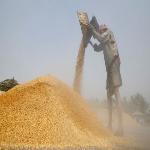March 12, 2011

Photo: Reuters
A laborer works at a rice mill on the outskirts of Agartala, capital of India's northeastern state of Tripura, March 3, 2011
Some of India's most remote farming villages are beginning to see sundown in a new light, now that they are able to convert an abundant crop into electricity.
Remote regions are prime examples of what people describe as old India - parts of the country off the grid, literally, from new India and its high-tech urban centers.
Tamkuha, in the Indian state of Bihar, does not receive electricity from the country's main distribution network. It gets by on traditional farming - and for decades, as the sun went down, villagers turned to the dim light of candles or kerosene lamps.
But these days, thanks to an ambitious renewable energy project, life in Tamkuha no longer grinds to a halt around 6:00 p.m. By the glow of florescent bulbs, residents have been able to extend their hours of productivity late into the night.
A woman says she used to work as a tailor only during the day.? Sewing was nearly impossible with a kerosene lamp. Now, she says she can work in her shop until very late at night.
Husk power
The source of the new electricity is something Tamkuha has in abundance: rice.
The startup company Husk Power Systems has designed a system fueled by the husk of rice plants - usually discarded after the rice grains are harvested. When heated, rice husks release flammable gas that can be used to power electric generators. A small plant can light up several hundred households for more than six hours at a time.
HPS Chief Operating Officer Ratnesh Yadav says the company's technology is a new spin on renewable energy. He says he started by looking at solar power and other options, but those seemed expensive.? People out here were dumping rice husks as waste - so, he looked into making use of it. That was three and a half years ago, he says, and since then his company has set up about 60 husk power plants in India.
Husk power makes villages like Tamkuha less isolated by helping residents charge mobile phones. The electricity is also giving the village new access to commerce and services during the night hours.
Shopkeepers can sell food and other needed items. The village doctor, Farooq Ansari, can continue to see patients.
He says when he began his medical practice 27 years ago, he had trouble running the clinic at night. With kerosene lamps, he had to close down everything by 7 or 7.30 in the evening. Now, with electric lights, he says he can serve his people at the clinic until 11 at night.
Young students like Priyanka Yadav say electricity has given them a new lease on learning. She says she used to study by kerosene lamp. It was stressful and she could not study for long. Now she says she can study until midnight if she wants.
The husk power project is supported in part by the Indian government - which has set a target of deriving 15 percent of the country's energy from renewable sources by 2020. But HPS Regional Manager Sanjay Chauhan says residents of Tamkuha are seeing a big change in their lives right now.
"Dream comes true"
He says villagers tell him it's like a dream come true. They never dreamed that electricity would come to this area. He says they are coming to understand how electricity can change their lives.
Yadav says previously young people here could never think of doing anything beyond village level farming. But now they are dreaming of becoming doctors, engineers and scientists. The arrival of electricity, he says, is raising their ambition.
That is exactly the kind of ambition and talent new India will need as it ascends to superpower status on the world stage - nurtured by one of the most abundant by-products of old India's agriculture.